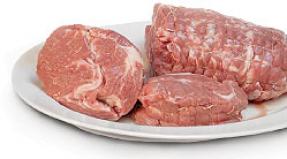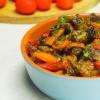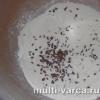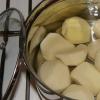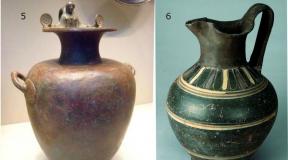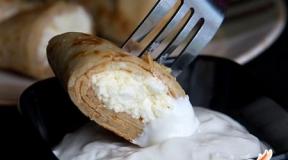How to make canned fish in the oven. Canned fish
Fishing is considered successful when the fish is not only caught, but also eaten.
What to do with a big catch? It is impossible to cook all the fish at once. Give it to friends? A good option.
Fisherman's Kitchen - Canning Fish at Home
The rest of the catch is rolled up in banks.
The fish is canned without hot sauces with a small amount of seasonings. Salt is often the only preservative. Such canned food is called natural. Use as an appetizer with rice, potatoes. Make sandwiches.
Natural canned food is safely given to children. They prepare soups and borscht (added at the last moment before turning off the stove), second courses, hodgepodge.
Experienced fishermen know recipes for making canned fish.
Canned fish in oil
Small fish are used whole, large ones are cut into pieces. Any river fish goes. The vegetable oil is of high quality. Before conservation, the product is collected, fried, and used raw.
Fish for raw preservation is cut, cleaned of scales, washed, large specimens are cut into pieces. Two tablespoons of salt are added per kilogram of fish.
Bay leaves, peppers, cloves are placed on the bottom of the cans. The fish is placed tightly up to the neck of the cans, poured with oil, covered with lids, and placed in a pressure cooker.
Pour water until the neck of the cans narrows, bring to a boil over high heat, reduce the fire, cook for three hours. After turning off the fire, do not open the pan, allow the jars to cool completely in water.
The delicacy is ready. Pies are baked from it, eaten, seasoned with lemon juice.
Useful and interesting: (no dirt in the kitchen) - 5 ways.
Canned fish in tomato sauce
The aroma and special taste is given to the fish by tomato sweet and sour sauce - it contains spices. Sea and river fish are prepared.
The process begins with cleaning the scales. Carcasses are washed well, tails and fins are cut off, and fried. Broth is cooked from the cut pieces as if on the ear.
When boiled, filter, add onions, carrots, tomato paste, bay leaves, vegetable oil, store fish seasoning. They simmer over low heat.
While the filling is being prepared, the fish are placed in sterilized jars. Pour the filling up to the throat, put it in a saucepan and sterilize it for 7-8 hours under a lid.
A towel is placed on the bottom of the pan under the jars before sterilization. Banks are rolled up hot. Fish prepared in this way costs a year.
In an Autoclave:
Canned fish in jelly and spicy salting
Eel, salmon, oily herring are good cooked in jelly. Pieces of fish are boiled with spices, filtered, gelatin is added. Boiled fish is poured with broth. The jars are stored in the refrigerator so that the jelly does not melt in the heat.
Canned food is considered a delicacy, served on slices of bread.
For spicy salting, small miscellaneous fish are suitable, which ripens when salted without heat treatment.
A cool brine is prepared - half a liter of water, 100 g of salt, boiled. Prepared fish is poured into cooled down, put under oppression for 5-6 hours.
Then they make a marinade with spices and spices, pour in salted fish. Mustard, vinegar and sugar are required ingredients in the marinade.
This type of canned food is called preserves. They are prepared without sterilization. Store in a refrigerator at a temperature of about zero degrees for 2-3 months.
Preserves are eaten with boiled potatoes, hard-boiled eggs. Combine with olives, onions.
All NHNCH (No tail, no scales)!
Hello to all readers of my blog. Today I devote an article to fishing enthusiasts. As I said earlier, my husband loves to fish, and this is not only summer fishing. He fishes all year round.
So we had to figure out what to do with a lot of river fish. Of course, part of the fish goes to cooking various dishes, another part is used to cook ram. And it is eaten with beer with great pleasure! But there is still a way to preserve the fish. How do we do it?
We prepare canned fish at home. To be honest, my beloved husband is engaged in the entire procurement process. And I'm just happy about that. Well, I don't like cleaning fish! What can you do about it?
True, the cooking process is not short. We will cook it in the oven. But it's really worth it! And I would also call this dish not just economical, but super economical. Don't believe me! Then take a look at the ingredients you need.
Required Ingredients
- any river fish
- salt to taste
- peppercorns
- seasoning for fish
- Bay leaf
I am not specifying the amount of ingredients here, since you will taste the salt and seasoning. And I will indicate the amount of pepper and bay leaves below.
How to make
To prepare this dish at home, do the following:
- We clean, gut and wash the fish.
- Then we cut the fish into pieces.
- Add salt and seasonings to taste.
- We leave the fish for an hour and a half so that it is saturated with all the aromas of spices.
- During this time, my banks. We usually use half liter.
- At the bottom of each jar, put two bay leaves and three peppercorns.
- After that, fill the jars with fish and cover them with foil on top.
- Then we put the jars on the wire rack in the oven, and under them we put a baking sheet with water. We do this so that the liquid boiling in the cans does not stain the oven and does not burn.
- We install the grill on the second division from the bottom. The temperature in the oven is 180 degrees.
- After boiling, the temperature decreases to 100 - 120 degrees.
- In general, the fish is stewed for 8 hours. After such processing, the bones in canned fish become very soft.
- About half an hour before the end of cooking, heat up the vegetable oil and carefully pour it into the jars.
- Cover the jars with metal lids and keep them in the oven for another half hour. At the end, of course, we roll up the cans.
Our homemade fish stock is ready!
Of course, it is much more convenient to prepare this dish in an autoclave. Here here you can purchase it.
Hello dear readers of my blog! My husband is an avid fisherman and regularly brings a large catch. I cook and, but still there is a lot left. I found a way out of this situation! Now I make canned fish at home. It turns out very tasty and you do not need to choose bones during meals.
Such a blank can be stored for several months. It is eaten quickly, but we always have a few jars for the winter in stock. Canned fish are very convenient to use: you can have a snack or make a quick dinner, use to prepare dishes for a festive table, take with you on a trip. Even .
They can be made from absolutely any fish: small and large, river and sea. For cooking, an autoclave, oven, stove, multicooker or pressure cooker are suitable. There is simply no more universal way to process your catch! Yes, I do how to make stew in an autoclave.
Recipe for canned small river fish in the oven in cans
I prefer this option for its simplicity and always a good result guaranteed! You can use any fish in it and cook simply in the oven, without a special autoclave. Jars are stored in the refrigerator, but we do not have them for more than a couple of months 🙂
You will need for a half-liter jar:
- 500 g of fish;
- 1 bay leaf;
- 5 black peppercorns;
- 2 allspice peas;
- 2-3 tbsp vegetable oil;
- salt to taste.
How to do:
1. Scale the fish, gut, remove the head, fins and tail. Rinse thoroughly, removing all dark films from the abdomen. So there will be no bitterness.

2. Cut the carcasses into portions and weigh. Salt at the rate of 1 tbsp. salt without a slide for 1 kg of fish. Stir well so the pieces are evenly salted. Leave for 10-15 minutes.

3. Prepare clean, dry 1/2-liter jars for now. In each, put 1 bay leaf, 5-6 black peppercorns and a couple of allspice peas. Now fold tightly into pieces. In the process of cooking, it will still sit down.

4. Pour 2-3 tablespoons into each jar. vegetable oil. Cover them with the sealing caps after removing the rubber rings. Or just wrap the necks of the cans with foil.

5. The workpieces must be placed in an unheated oven. It is important! Place them on the wire rack. And put a baking sheet with water at the bottom to avoid strong direct heat.

6. Turn on the oven at 150 ° C for 1 hour. Then reduce the temperature to 100 ° C and simmer for another 4-5 hours.
7. Insert the rubber rings into the caps (if you removed them) and immerse them in hot water for about 30 seconds. This will soften the rubber and better adhere to the neck. Roll up the cans.

The fish is very tasty, even the backbones become soft. To keep the jars full, you can decompose canned food from one jar into others before rolling.

Very tasty to serve as a side dish or.
Canned fish at home in a slow cooker - a recipe for small crucian carp
In this version, the taste of the finished product will be richer thanks to the use of vegetables. The multicooker will create all the necessary conditions: stewing under steam pressure and preserving all the juices. You can put a little more vegetables - there will be a side dish.
For the recipe, take:
- 1.5 kg of crucian carp;
- 1 large carrot;
- 3 onions;
- 1 head of garlic;
- 2 tbsp tomato paste;
- 5 tbsp sunflower oil;
- 200 ml of water;
- ground black pepper;
- salt.
Preparation:
1. Peel the carrots and cut into large rings. Chop the onion into rings. Cut the peeled garlic cloves into halves.
2. Free the fish from the scales and gut. Remove the head, all fins and tail. Cut the carcasses into pieces, about 4-5 cm.

3. Pour 2 tablespoons into the multicooker bowl. oils. Layer the first layer of carp slices. Season with salt and pepper.
4. Lay out the remaining fish. Season with salt and pepper again.

5. Top layer with carrot slices, garlic and onion rings. Press down a little with your hands. Season with salt again. Spread the tomato paste on top (ketchup can be used) and add the remaining oil. Pour in water.

6. Turn on the "Stew" mode for 6 hours for medium-sized crucians and for 4 hours for small fish.
During the cooking process, water can be added so that the canned food does not burn.
Try it, it's incredibly delicious! Especially with boiled potatoes!

How to cook homemade canned fish in an autoclave on the stovetop?
Autoclave is a homemade homemade factory. With it, you can be sure of the complete tightness and sterility of the product. The product has a long shelf life. Follow the instructions in the recipe to keep the lids from coming off.
Ingredients for 1 can of 0.5 l:
- mackerel or any other fish.
- 1 tsp salt;
- 4 allspice peas;
- 10-12 peas of black pepper;
- a pinch of whole coriander;
- ¼ tsp ground paprika;
- Bay leaf.
Cooking steps with a photo:
1. Prepare fish: gut, remove head, fins and tail, rinse. Cut into 3-4 cm pieces.
2. Prepare screw jars. Make sure they are all the same height. Put ½ tsp on the bottom of each. salt, 2 allspice peas, 5-6 black peppercorns and coriander.

3. Fill the jar halfway with the pieces of fish. Sprinkle with the remaining ½ tsp. salt, add 2 more allspice peas, 5-6 black peas and paprika. Pour the pieces of fish to the top of the jar without tamping, but firmly. Place the bay leaf at the end. Screw on the cover tightly until it stops.

4. Now place the blanks on the trays of the autoclave. To prevent the cans from turning, place a cloth on top and bottom.
To evenly distribute the load, place the jars strictly one under the other. If there is free space on the pallet, put "dummies" - cans of water.

5. Secure the upper tray with screws and transfer the entire structure to the autoclave pan. Fill it with water up to the mark indicated in the instructions. Close the lid and turn on medium heat. This is especially important when the fish is not completely thawed. On medium heat, it will warm up evenly and the jars will not burst from the temperature difference.
6. After the autoclave heats up to 110-112 ° C, cook for 30 minutes. Then turn off the heat and, without opening the lid, wait until the temperature drops to 40 ° C. After that, remove the cans from the autoclave, turn upside down and leave to cool completely.

7. Soak canned food for 2-3 weeks. After 2 weeks, the fish will taste like lightly salted. After 3 weeks, it will fully "mature".
This is canned food in its own juice. If desired, you can add 50 ml of vegetable oil to each half-liter jar. Then the taste will be like sprats. How else to cook delicious fish in an autoclave,.

Canned fish at home in a pressure cooker in oil
A pressure cooker is, in terms of time, something between an autoclave and a multicooker. Very comfortably! Mackerel itself is a fatty fish, and even with such a minimal set of ingredients, it turns out to be very tasty. The ingredient is listed in a half liter jar.
Required products:
- mackerel;
- 1.5 tsp rock salt;
- 3-5 peas of black pepper;
- 1 bay leaf;
- 1 tbsp vegetable oil.
Step-by-step instruction:
1. Rinse and butcher the mackerel. Cut the carcasses into 3-4 cm pieces.
2. Place the pieces tightly in 1/2 liter screw jars. Add bay leaves, black peppercorns and salt to each jar. Pour 1 tablespoon on top. vegetable oil. Screw the caps on tightly. If you plan to store for a long time, add half a glass of water to the jars.

3. Place a cloth on the bottom of the cooker and place the jars. Pour in 1 glass of water and close the lid and valve. Select the "Simmering" or "Quenching" mode and set the timer for 2 hours. Turn off the "heating".
After such a mackerel, you will no longer want canned food from the store.
Making canned fish at home in tomato glass jars
Pike and tomato sauce are just a great combination! Tomatoes add a little sourness and completely cover the smell of river fish. Carrots and onions add flavor and aroma. You will be surprised how delicious it will turn out!
2. Transfer the pike pieces to a bowl, add the tomato paste, salt and pepper. Mix everything thoroughly and leave to soak for 10-15 minutes.
3. Put half a bay leaf in each half-liter jar at the bottom. Add some onions and carrots to several jars. Now, fill the jars with bay leaves with fish as tightly as possible, up to the "shoulders". Put a layer of pike in jars with carrots and onions, then some vegetables again, and bring the fish to the "shoulders". Above is the last layer of carrots and onions.

4. Pour boiling water over the lids for 30 seconds to soften the rubber ring. Roll up the cans and turn them upside down.
5. Prepare the autoclave. Transfer the cans to pallets, placing them strictly one under the other. Fasten the top pallet tightly with the screws so that the cans do not twist. Transfer the structure to the autoclave pan. Pour in water, not reaching the top of 3-4 cm. To prevent scale formation, pour in 20 ml of vinegar. Close the lid and put on fire.

6. When the temperature reaches 115 ° C, reduce heat to low and cook for 30 minutes. Then turn off the heat and leave the autoclave closed, cool down to at least 40 ° C. Then release the remaining pressure and remove the cans.
The smell and taste of canned food are reminiscent of Soviet ones. Try it - it's impossible to tear yourself away!

Now a big catch for you will not be an extra concern, but an anticipation of the most delicious canned fish. Be sure to share these recipes with your friends and family, and they will forget how to buy blanks in the store. Come to the pages of my blog for new culinary discoveries! Bye bye everyone!
Canned fish is rightfully considered a universal dish. Experienced housewives prefer to cook the product for future use in order to be able to enjoy it at any time of the year. Store-bought canned food is loaded with preservatives, thickeners, flavor enhancers and additives that are detrimental to health. Homemade preparations are distinguished by their natural composition, therefore they are of better quality and healthier. We will give practical recommendations, highlight the main aspects.
Cooking features
- For the preparation of canned food, you can use any fish, both sea and river. However, experienced housewives, through trial and error, have identified certain varieties that are optimal for harvesting. Give preference to carp, pike, tench, bream, roach, crucian carp and other species that live in large bodies of water. As for sea fish, mackerel, capelin, sprat are most often canned.
- Fish suitable for home preparation should not be damaged. Inspect the carcass carefully before preserving it, use only fresh produce. In most cases, corn, olive or vegetable oil is added to the product. This ingredient improves palatability and increases shelf life. You can often find recipes based on tomato sauce with seasonings and aromatic spices.
- Canned fish are rolled into small cans. The optimal volume is from 0.3 to 1 liter. Before placing the finished product in containers, they must be sterilized. For these purposes, a water bath is used. To carry out the procedure, take a wide saucepan, place a cloth or board on the bottom, put a jar. Cover with water, simmer over medium heat for a quarter of an hour. Do the same with the lids.
Sprats in wine
- fish (small) - 0.8 kg.
- vegetable oil - 100 ml.
- dry white wine - 145 ml.
- onions - 3 pcs.
- pepper (peas) - 5 pcs.
- laurel leaf - 6 pcs.
- vinegar solution (table) - 45 ml.
- seasonings (optional) - to taste
- salt - 55 gr.
- Small fish (sea or river) are suitable for the preparation of canned food. Give preference to minnows, roach, perch, ruff, dace, etc.
- After choosing the raw material, clean the carcasses from the scales, remove the intestines and clear the cavity from the dark film. Wash the fish thoroughly under running water, dry it so that it does not soften.
- Choose the optimal saucepan with thick sides and bottom, cut the onion into rings, put one part in a container in a thin layer. Now arrange small fish in one row, salt on top. Layer the onions again, alternating the ingredients until the pan is 2/3 full.
- After that, add the peas, add the bay leaf, pour in the oil. Mix table vinegar (concentration 9%) with white wine, pour over the fish. If desired, you can replace the wine with drinking water, observing the proportions.
- Cover the pan with a lid, place on the stove, simmer on minimum power for about 4-4.5 hours. The owners of pressure cookers will have much easier, the duration of the simmering is reduced to 1.5 hours.
- The structure of the fish will tell you about the readiness of the product. The carcass has such soft bones that they literally melt in your mouth, you will not notice them. As soon as a similar consistency is reached, roll up the product in sterile jars, send it to the cellar for long-term storage.
Sprat with vegetables in tomato
- sprat - 2.8-3 kg.
- carrots - 0.7 kg.
- fresh tomatoes - 2.8 kg.
- onions - 0.8 kg.
- coarse salt (preferably sea salt) - 200 gr.
- vinegar - 90 ml.
- beet sugar - 250 gr.
- bay leaf - 10 pcs.
- pepper (peas) - 14 pcs.
- Peel the entrails of capelin, roach or sprat, cut off the heads, tails and fins. Wash and dry the carcasses. Rinse the tomatoes with water, remove the stalks, pass the vegetables through a food processor, blender or meat grinder, pour the tomato juice into an enamel saucepan. Turn on the burner to a minimum, cook chopped tomatoes for about half an hour (until boiled down). Then add sugar, salt, stir until the crystals dissolve.
- Peel the carrots, grate on a coarse grater. Cut the onion into half rings, fry the vegetables until golden brown in sunflower oil. Send the frying to the tomatoes, stir, simmer under the lid for another 10 minutes, turn off the stove.
- Take a thick-walled saucepan. Put a layer of boiled tomatoes on the bottom with fried, then add the fish, placing it in one row. Fill the pot 2/3 full, without fail the last layer should be vegetable. Add peas, laurel, and other seasonings as desired.
- Cork tightly with a lid, simmer for 3 hours, do not stir. A quarter of an hour before the completion of the procedure, take a Chinese stick, make holes in the canned food. Pour vinegar over the mixture so that it flows into the holes and soaks the composition.
- Sterilize containers and lids in a water bath, dry them so that moisture does not get into the canned food. Package the finished product, roll up, cool at room temperature. Store in a basement or cellar.
Silver carp in oil
- silver carp - 1 kg.
- olive or vegetable oil -300 ml.
- ground black pepper - 20 gr.
- sea salt - 60 gr.
- First of all, you need to butcher the fish. Cut off the head, tail, fins. Take out the insides, scrape off the dark film in the cavity. Wash the carcass, dry it with paper towels.
- Cut the fish into thin slices; you can remove the ridge if desired. Fillet lovers are advised to remove the skin, then chop the carcass into small wedges.
- Prepare jars, sterilize them in a convenient way. You can put the containers in the oven and heat well. Some perform the procedure using a water bath (boil for about 20 minutes).
- After sterilization, dry the container, begin to lay out the fish slices in layers, overlapping each row with salt and ground pepper. Fill the container in such a way that the fish reaches almost to the neck (1-2 cm indent). After all the manipulations, fill the product with oil.
- Now pick up a wide, thick-bottomed saucepan, place a thick cloth or board. Put jars in it so that they do not touch each other. Pour in water, the liquid should reach the middle of the cans.
- Boil the food for about 20 minutes until the bones (if any) are completely softened. Before turning off the hotplate, take 1 slice and taste it. If everything is ok, roll up the cans and cool naturally.
Sprats in a multicooker
- fish (any) - 1 pc. big size
- carrots - 1 pc.
- tomato paste - 60 gr.
- onions - 2 pcs.
- vinegar - 25 ml.
- salt - 70 gr.
- seasonings - at the discretion
- Gut the carcass, remove the head, fins, tail, remove the scales. Remove the bubble from the fish cavity. Follow the steps carefully, otherwise it will tear and give the sprats bitterness.
- After all the manipulations, wash the carcass, dry it with paper towels, cut into slices. Then mix the seasoning with salt, rub the fish on all sides.
- Take out the multicooker bowl, put the raw materials in it, start making the sauce. Dilute tomato paste 1: 1 with water, stir. Pour in the vinegar, pour the resulting sauce over the fish.
- Peel and coarsely grate the carrots, chop the onions into rings, place the cooked chopped vegetables on top of the fish in the sauce. Place the multi-bowl in the appliance, close the lid, set the "Extinguishing" mode.
- To check the readiness of the sprat, take out a small piece and taste it. The bones should become soft, barely visible. After braising is complete, roll the fish in sterilized jars, send it to storage, or start eating right away.
Sprats in tomato
- fish (any) - 1.3 kg.
- tomatoes - 2.1 kg.
- salt - 30 gr.
- vegetable oil - 150 ml.
- onions - 320 gr.
- pepper (peas) - 6 pcs.
- bay leaf - 7 pcs.
- granulated sugar - 150 gr.
- salt - 35 gr.
- vinegar - 100 ml.
- vegetable oil - 40 ml.
- wheat flour - 30 gr.
- Gut the fish, prepare the carcass for conservation. Wash it, cut it into small pieces. Rub the slices with salt and let sit for 1 hour. At this time, start preparing the tomato sauce.
- Wash the tomatoes, remove the stalks, place in a wide enamel pot. Pour in a little water, add seasonings, vegetable oil, granulated sugar and vinegar. Cook the vegetables for about half an hour, then turn off the hotplate.
- Rub the tomatoes through a sieve or chop them in a blender / meat grinder. Add vinegar, then put on the stove again, simmer over medium heat for 30 minutes. At this time, fry the fish slices in a pan after dipping them in flour.
- Sterilize the jars, dry them, otherwise even a drop of water can spoil the whole product. Place the fish in containers, pour the resulting tomato juice. Place in a wide saucepan and simmer in a water bath for about 1 hour.
- After the due date, roll up the container, put it to sterilize, the duration of the procedure is 4 hours. In order not to rip off the covers, fix the special holder. Next, take out the twists, turn them upside down, cover with a warm cloth. Let cool under natural conditions, send for storage.
Preserving fish in the oven
Sprats can be cooked not only in a multicooker or on the stove, but also in the oven. Remember a few important rules to carry out the conservation correctly.
- Choose jars of the same size so that the composition is evenly soaked. In this case, the optimal volume is considered to be 0.3-1 liters.
- Before storing raw materials, sterilize and dry the containers, otherwise the cans may explode during storage. Spread the fish so that there are no gaps.
- To make the fish steamed well, wrap the neck with cling foil. Make sure that no air enters the cavity, otherwise the product will dry out.
- Place a baking sheet with water on the bottom shelf to moisten. In this case, the containers with the composition are stirred in the middle of the oven.
- After you send the cans with the contents inside, wait until it boils, then turn the power down to 100 degrees. Preserve sprats in this mode for 5 hours, then fill with hot vegetable oil and cork.
It is not difficult to prepare sprats if you have knowledge of the technologies available. Choose fish to your taste and wallet, consider recipes based on tomato juice, vegetable oil, add spices and seasonings as desired. Preservation of fish is an easy process, the main thing is to observe important features, observe the proportions and duration of exposure.
Video: canned fish at home


